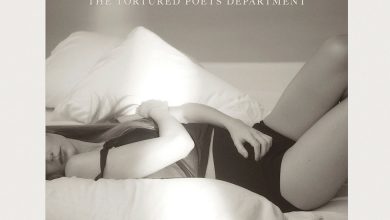‘32 Sounds,’ a Film Performed Live, Probes the Power of Listening

Early in Sam Green’s relentlessly curious documentary “32 Sounds,” the filmmaker asks an employee of the British Library Sound Archive — one of the world’s largest collections of audio recordings — if she has a favorite sound. Choosing among the archive’s nearly 7 million options, she cues up a 1987 recording of the mating call of the Moho braccatus, a Hawaiian bird with dark plumage and bright shocks of yellow sprouting from its legs.
The Moho braccatus was declared endangered in 1973, and by the early 1980s its population had dwindled to two, one male and one female. In 1982, the female was killed in a storm. And so this heartbreaking recording depicts the male’s determined mating call — a lilting, hauntingly hopeful whistle — ringing out five years after the death of the only bird who could possibly answer it.
The Moho braccatus’s mating call is one of the most memorable of the 32 sounds Green alludes to in his freewheeling documentary’s title; there are also, among others, muffled gurgles from inside the womb (sound number one, naturally), the sound of a tree falling in the woods (playfully and expertly reconstructed by the Foley artist Joanna Fang), and even the sound of silence, as demonstrated by a particularly delightful montage of a wide variety of musicians performing “4’33”,” by John Cage.
At the beginning of a showing of “32 Sounds” Friday evening at the Brooklyn Academy of Music’s Fisher theater, following celebrated runs at Sundance and SXSW, Green himself announced to the audience, “We’re going to make a documentary film about sound,” highlighting the transitory and participatory nature of what was about to take place. “32 Sounds” is the latest of what the Oscar-nominated Green calls his “live documentaries,” a hybrid form that combines conventions of a film screening, a theatrical performance and a live concert to create a unique and ephemeral experience. (His previous works include “The Love Song of R. Buckminster Fuller,” which featured the rock band Yo La Tengo performing an original score at screenings, and “A Thousand Thoughts,” which he made in collaboration with the writer Joe Bini and the Kronos Quartet.)
At live showings of “32 Sounds,” Green himself provides in-person narration, while the musicians JD Samson and Michael O’Neill perform, in real time, Samson’s eclectic, largely electronic score. With the narrator and musicians seated in front of the movie screen, proudly displaying their processes, the effect is as though one has unscrewed the top of a traditional documentary to expose its busily whirring component parts.
Each audience member is also given a pair of headphones — Green and his crew travel with 500 of them — to better immerse themselves in the film’s soundscapes, and particularly for its experiments with binaural audio. Among the lively cast of characters Green meets in his wide-ranging meditation on sound and human memory is the Princeton physicist Edgar Choueiri, who experiments with recordings that mimic three-dimensional sound. He demonstrates this viscerally, shaking a matchbox at various points around a binaural microphone; wearing headphones, the listener can detect the clattering matches moving around in space. It’s heady and spine-tingling, like high-tech ASMR.
While there’s certainly a specific charm to seeing “32 Sounds” live (particularly during a five-minute interactive dance break, when Green invites audience members to walk up to the stage and feel the quaking power of a pair of subwoofers as Samson acts as D.J.), the filmed narrative is engaging and richly visual enough that “32 Sounds” would still achieve many of its most spectacular effects at home, preferably through a pair of good headphones. (It played virtually at Sundance and is the first of Green’s live documentaries that, in addition to being performed live, will eventually be able to stream.)
If there’s a star of “32 Sounds” (aside from the human ear), it’s the spirited Annea Lockwood, an 82-year-old experimental composer who has been making field recordings of rivers for more than 50 years. There’s a contagious wonder on her face as she invites Green, and the viewer, to listen to the loquacious chatter of organisms picked up by her underwater microphone. She prefers the term “listening with” rather than listening to — a non-hierarchical way of framing humans’ coexistence with the sonic environments all around them.
Much like Cage’s “4’33”” or the composer Pauline Oliveros’s philosophy of “deep listening,” Green’s film aims to sharpen the viewer’s (er, listener’s) sense of hearing by redirecting awareness to the everyday environmental sounds one too often takes for granted. His 95-minute exploration prefers to leapfrog across several dozen scintillating surfaces, though, rather than approaching the type of depth or stillness Lockwood seeks with her river recordings. The formal structure of “32 Sounds” is a nod to François Girard’s 1993 experimental biopic “Thirty Two Short Films About Glenn Gould,” and its chattily inquisitive tone is occasionally reminiscent of an audiovisual episode of “This American Life.”
What gives the film a lingering gravitas, though, is how often Green’s sonic journeys lead him back to contemplating grief and loss. One man’s trash is another man’s aural treasure, as Green finds with the answering machine tapes he’s saved to preserve the voices of deceased loved ones. Lockwood admits that part of the reason she “listens with” the chirping creatures in her backyard each evening is that she finds the experience of listening to music too emotionally intense since her longtime partner, the composer Ruth Anderson, passed away several years ago.
In the earliest days of recorded sound, Green points out that the phonograph — the first technological development to allow deceased people’s voices to have an afterlife — was sometimes advertised as a means of “stopping death.” His film serves as a poignant reminder that, for all the incredible technical advancements of the past century or even the past decade, that particular goal still remains elusive. But whether through the personal preservation of sonic mementos like wax cylinders, voice mail messages or any number of yet-to-be-invented formats, that impossible impulse to press pause on mortality is likely to echo, like the Moho braccatus’s persistent call, well into the distant future.



